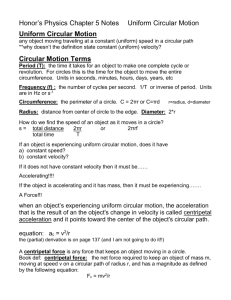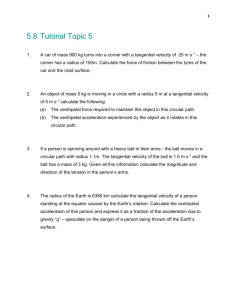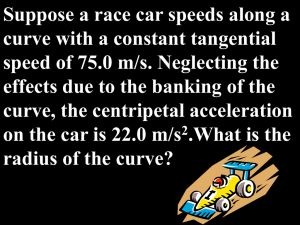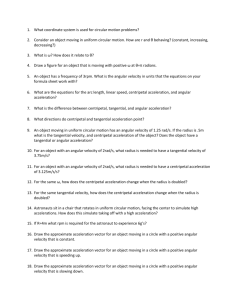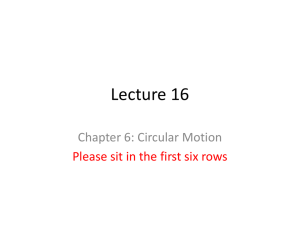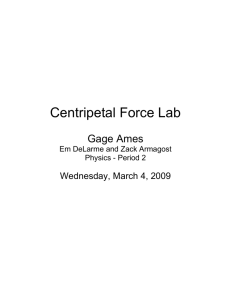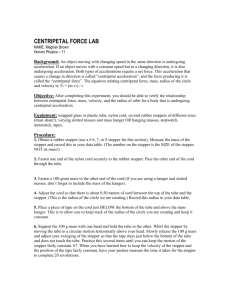Net Central Force Lab (Circular Motion) Objectives Students
advertisement
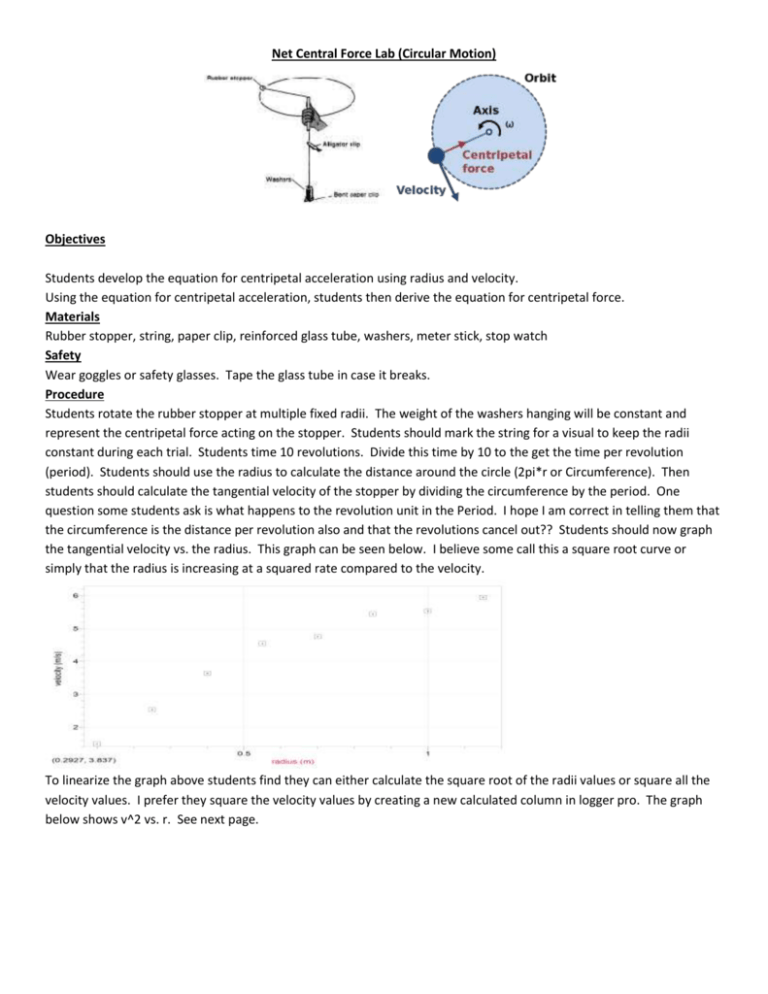
Net Central Force Lab (Circular Motion) Objectives Students develop the equation for centripetal acceleration using radius and velocity. Using the equation for centripetal acceleration, students then derive the equation for centripetal force. Materials Rubber stopper, string, paper clip, reinforced glass tube, washers, meter stick, stop watch Safety Wear goggles or safety glasses. Tape the glass tube in case it breaks. Procedure Students rotate the rubber stopper at multiple fixed radii. The weight of the washers hanging will be constant and represent the centripetal force acting on the stopper. Students should mark the string for a visual to keep the radii constant during each trial. Students time 10 revolutions. Divide this time by 10 to the get the time per revolution (period). Students should use the radius to calculate the distance around the circle (2pi*r or Circumference). Then students should calculate the tangential velocity of the stopper by dividing the circumference by the period. One question some students ask is what happens to the revolution unit in the Period. I hope I am correct in telling them that the circumference is the distance per revolution also and that the revolutions cancel out?? Students should now graph the tangential velocity vs. the radius. This graph can be seen below. I believe some call this a square root curve or simply that the radius is increasing at a squared rate compared to the velocity. To linearize the graph above students find they can either calculate the square root of the radii values or square all the velocity values. I prefer they square the velocity values by creating a new calculated column in logger pro. The graph below shows v^2 vs. r. See next page. next page Before having students write an equation for the linear graph, I challenge them to do a unit analysis to determine what the slope represents about the motion of the rubber stopper. The units m^2/s^2/m simplify to m/s^2, which are units of acceleration. Students then write the linear equation, v^2 = ac r. I then challenge the students to solve this equation for ac and write an equation for Fc. I find it helpful to students to remind them repeatedly that the centripetal force is just a generic name for the total force or sum of forces that causes circular motion. Students can then incorporate ac as v2/r into the Fc equation to come up with Fc = mv2/r. Independent/Guided Practice WS 1 and 2 from Schober’s Physics http://modelingphysics.org/circularmot/sframe.htm I created a test that follows. Test Circular Net Force Name _______________________________ Hr. _____ 1. Describe the direction of travel at one point for an object going in a circular motion? _____________________ 2. Draw an object in circular motion. Include a motion dot map and label one of the dots showing the direction of motion, acceleration and total force. 3. The ___________________________ of an object in circular motion is the time needed for the object to make one complete circle or orbit. Period, T, is equal to the orbit circumference divided by the tangential velocity. 4. Calculate the tangential velocity of the moon that orbits the earth every 27.3 days and the average radius is 385,000Km. Convert the v to m/s please. 5. Calculate the avg. distance of the Earth from the sun if the earth has a tangential velocity of 30.4Km/s. 6. As an object travels in a curved path, the ___________________ of its velocity changes. ____________________ acceleration is the name given to a change in velocity due to curved motion. Centripetal acceleration is directed toward the __________________ of the circle. ac = v2/r 7. If the radius of an object were to increase by 4 times, how many times would the Fc need to change by? 8. If the velocity of an object in circular motion were to increase by 3 times, how many times would the force centripetal change by? 9. The net force needed to curve an object away from straight line motion is directly proportional to the object's __________, directly proportional to the _____________ of the object's velocity and ________________ proportional to the radius of the object's path. 10. Calculate the Fnet that the earth exerts on the moon. The moon’s mass is 7.3 x 1022Kg. 11. What is the Fnet that the moon exerts on the earth? Hint, think Newton’s third law. 12. A net force causing circular motion is also called ________________ force = Fc 13. What provides the centripetal force for a car making a turn? ___________________________________ 14. _________________________ force is the name for the apparent force that "pushes" objects away from the center of a circle from the viewpoint of the object that is undergoing circular motion. Of course, there is no force pushing an object away from the center of the circle, it is simply the object traveling in a ______________________. 15. The central net force for a moon or planet in orbital motion is provided by ___________________________. 16. ___________________________________ refers to situations of freefall where the gravitational force is present, but there is no normal force. Your sense of weight arises from the _________________________ force on you. 17. ______________ tells how many times heavier than usual a person feels. 18. Construct a quantitative force diagram for a car driving through a dip in the road. The mass of the car is 400Kg. The radius of the dip is 5m. Label the forces on the car when it is at the bottom of the dip. Calculate the forces on the car. It’s velocity is 60miles/hr. r=5m


